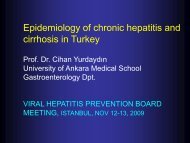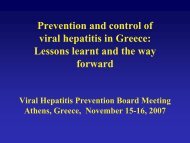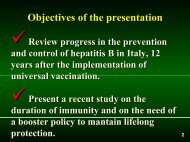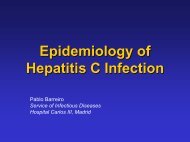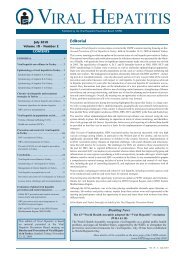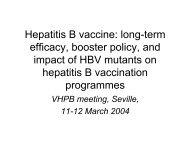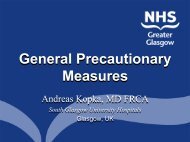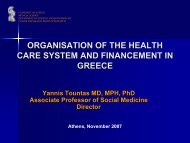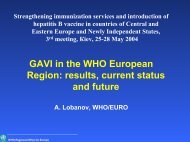Galetskii SA, Seniuta NB, Syrtsev AV, Abdullaev OM, Aliev DA, Kerimov AA, YamashitaM, Hayami M, Kato T, Mizokami M. Analysis <strong>of</strong> some viral <strong>in</strong>fections, transmitted byparenteral <strong>and</strong> sexual routes, <strong>in</strong> the Republic <strong>of</strong> Azerbaijan. Vopr Virusol 1999; 44:232-236.[Article <strong>in</strong> Russian]Representatives <strong>of</strong> various population groups <strong>in</strong> Azerbaijan were tested for <strong>in</strong>fection with humanT-lymphotropic (HTLV-I <strong>and</strong> HTLV-II) <strong>and</strong> hepatotropic <strong>virus</strong>es (HCV <strong>and</strong> HBV). A total <strong>of</strong> 835sera were studied by screen<strong>in</strong>g <strong>and</strong> specific tests for <strong>virus</strong>-specific antibodies <strong>and</strong>/or antigens.Thirty-five DNA specimens from peripheral blood lymphocytes were analyzed <strong>in</strong> the PCR forHTLV-I-specific sequences. No HTLV-I or HIV were detected, but two cases with <strong>in</strong>tegration <strong>of</strong>the HTLV-I LTR gene <strong>in</strong>to cellular DNA genome were detected. A high rate <strong>of</strong> <strong>in</strong>fection with<strong>hepatitis</strong> B <strong>and</strong> C was revealed. The level <strong>of</strong> anti-HCV was 8.7%, HBsAg 4.1%, <strong>and</strong> antiHBs23.4%. Six cases with double HBV-HCV <strong>in</strong>fection were detected. High values <strong>of</strong> ALT amongHBV/HCV-seronegative subjects prompts their test<strong>in</strong>g for other types <strong>of</strong> <strong>hepatitis</strong> <strong>virus</strong>es.Giles ML, Sasadeusz JJ, Garl<strong>and</strong> SM, Grover SR, Hellard ME. An audit <strong>of</strong> obstetricians'management <strong>of</strong> women potentially <strong>in</strong>fected with blood-borne <strong>virus</strong>es. Med J Aust 2004; 180:328-332.Cl<strong>in</strong>ical Microbiology <strong>and</strong> Infectious Disease, Royal Women's Hospital, 132 Grattan Street,Parkville, Victoria 3050, Australia. michelle.giles@rwh.org.auThe objective was to assess obstetricians' current antenatal screen<strong>in</strong>g practices for blood-borne<strong>virus</strong>es (<strong>hepatitis</strong> B, <strong>hepatitis</strong> C <strong>and</strong> HIV) <strong>and</strong> how they manage pregnant women <strong>in</strong>fected with ablood-borne <strong>virus</strong>. Design <strong>and</strong> participants: national cross-sectional survey conducted betweenSeptember 2002 <strong>and</strong> January 2003. All obstetricians (n = 767) registered with the Royal Australian<strong>and</strong> New Zeal<strong>and</strong> College <strong>of</strong> Obstetricians <strong>and</strong> Gynaecologists (RANZCOG) were mailed aquestionnaire assess<strong>in</strong>g their antenatal screen<strong>in</strong>g practices <strong>and</strong> knowledge <strong>of</strong> management <strong>of</strong>women potentially <strong>in</strong>fected with a blood-borne <strong>virus</strong>. Concordance <strong>of</strong> cl<strong>in</strong>ical practice withRANZCOG recommendations <strong>and</strong> current evidence-based guidel<strong>in</strong>es. 523 obstetricians (68%response rate) completed the questionnaire. Fifty-one per cent <strong>of</strong> respondents said they wouldalways <strong>of</strong>fer HIV screen<strong>in</strong>g <strong>and</strong> 60% would always <strong>of</strong>fer HCV screen<strong>in</strong>g. For HIV-<strong>in</strong>fectedwomen, 36% <strong>of</strong> obstetricians would always recommend elective caesarean section <strong>and</strong> 33% wouldalways avoid rupture <strong>of</strong> membranes. Despite a lack <strong>of</strong> evidence, 34% <strong>of</strong> obstetricians advisepatients that the risk <strong>of</strong> HBV <strong>transmission</strong> is <strong>in</strong>creased with breastfeed<strong>in</strong>g, <strong>and</strong> 47% give the sameadvice about HCV <strong>transmission</strong>. There is some discordance between the RANZCOG antenatalscreen<strong>in</strong>g recommendations for HCV <strong>and</strong> HIV <strong>and</strong> current practice. Knowledge about themanagement <strong>of</strong> HIV-<strong>in</strong>fected women could be improved, <strong>and</strong> more obstetricians need to be awarethat current evidence suggests there is no <strong>in</strong>creased risk <strong>of</strong> <strong>transmission</strong> <strong>of</strong> HBV or HCV withbreastfeed<strong>in</strong>g.Glikberg F, Brawer-Ostrovsky J, Ackerman Z. Very high prevalence <strong>of</strong> <strong>hepatitis</strong> B <strong>and</strong> C <strong>in</strong>Bukharian Jewish immigrants to Israel. J Cl<strong>in</strong> Gastroenterol 1997; 24:30-33.Department <strong>of</strong> Family Medic<strong>in</strong>e, Hadassah University Hospital, Mount Scopus, Jerusalem, Israel.In Israel, the reported prevalence <strong>of</strong> <strong>hepatitis</strong>-C <strong>virus</strong> (HCV) <strong>in</strong>fection among blood donors is0.44%. As we found a high prevalence <strong>of</strong> chronic <strong>hepatitis</strong>-B <strong>virus</strong> (HBV) <strong>and</strong> HCV <strong>in</strong>fection <strong>in</strong>Jewish immigrants from Uzbekistan <strong>and</strong> Tajikistan (Bukharian Jews) among our general patientpopulation, we determ<strong>in</strong>ed the prevalence <strong>of</strong> HBV <strong>and</strong> HCV <strong>in</strong>fection among ‘healthy’ BukharianJewish immigrants by screen<strong>in</strong>g for HBV <strong>and</strong> HCV markers <strong>and</strong> risk factors <strong>in</strong> a population <strong>of</strong>Bukharian Jews <strong>in</strong> north Jerusalem. A total <strong>of</strong> 27 (26.5%) <strong>of</strong> 102 patients were anti-HCV positive(by ELISA <strong>and</strong> confirmation tests). The HCV positive patients were older <strong>and</strong> had a higher rate <strong>of</strong>16
liver enzyme abnormalities than were the HCV-negative patients (56.5 +/- 2.3 versus 47.6 +/- 1.8,p = 0.003; <strong>and</strong> 14 <strong>of</strong> 27 versus 7 <strong>of</strong> 75, p < 0.01, respectively). HCV-positive patients with liverenzyme abnormalities were younger than HCV-positive patients without liver enzymeabnormalities (52.5 +/- 3.0 versus 62.8 +/- 2.8, p = 0.02). Sixteen patients (15.7%) were <strong>hepatitis</strong>-B surface antigen (HBsAg) carriers, <strong>and</strong> only two <strong>of</strong> these HBsAg carriers had liver enzymeabnormalities. None <strong>of</strong> the HCV-positive patients were HBsAg carriers (0 <strong>of</strong> 27 among HCVpositivepatients versus 16 <strong>of</strong> 75 among HCV-negative patients, p = 0.0055). Past <strong>in</strong>fection withHBV was found <strong>in</strong> 67 exam<strong>in</strong>ees (66%) (45 <strong>of</strong> 75 HCV-negative patients <strong>and</strong> 22 <strong>of</strong> 27 HCVpositivepatients, p = 0.058). However, similar proportions <strong>of</strong> patients from both groups had past<strong>and</strong> present exposure to HBV [61 (81.3%) <strong>of</strong> 75 among HCV-negative patients versus 22 (81.5%)<strong>of</strong> 27 among HCV-positive patients]. Only 14 patients (13.7%) had no exposure to either HCV orHBV. Possible risk factors were use <strong>of</strong> nondisposable needles dur<strong>in</strong>g mass vacc<strong>in</strong>ation <strong>in</strong> theU.S.S.R. or possible <strong>in</strong>trafamilial spread. The study concluded that immigrant Jews from formerAsiatic U.S.S.R. republics have the highest rate <strong>of</strong> HCV positivity ever reported, <strong>and</strong> many <strong>of</strong>them have past <strong>and</strong> present HBV <strong>in</strong>fection. Measures to prevent <strong>in</strong>trafamilial <strong>transmission</strong> <strong>of</strong> both<strong>virus</strong>es should be <strong>in</strong>stituted.Goldste<strong>in</strong> ST, Zhou F, Hadler SC, Bell BP, Mast EE, Margolis HS. A mathematical model toestimate global <strong>hepatitis</strong> B disease burden <strong>and</strong> vacc<strong>in</strong>ation impact. Int J Epidemiol 2005; 34:1329-1339.Division <strong>of</strong> Viral Hepatitis, Centers for Disease Control <strong>and</strong> <strong>Prevention</strong>, Atlanta, GA 30333, USA.sgoldste<strong>in</strong>@cdc.govLimited data are available regard<strong>in</strong>g global <strong>hepatitis</strong> B <strong>virus</strong> (HBV)-related morbidity <strong>and</strong>mortality <strong>and</strong> potential reduction <strong>in</strong> disease burden from <strong>hepatitis</strong> B vacc<strong>in</strong>ation. A model wasdeveloped to calculate the age-specific risk <strong>of</strong> acquir<strong>in</strong>g HBV <strong>in</strong>fection, acute <strong>hepatitis</strong> B (illness<strong>and</strong> death), <strong>and</strong> progression to chronic HBV <strong>in</strong>fection. HBV-related deaths among chronically<strong>in</strong>fected persons were determ<strong>in</strong>ed from HBV-related cirrhosis <strong>and</strong> hepatocellular carc<strong>in</strong>oma(HCC) mortality curves, adjusted for background mortality. The effect <strong>of</strong> <strong>hepatitis</strong> B vacc<strong>in</strong>ationwas calculated from vacc<strong>in</strong>e efficacy <strong>and</strong> vacc<strong>in</strong>ation series coverage, with <strong>and</strong> withoutadm<strong>in</strong>istration <strong>of</strong> the first dose <strong>of</strong> vacc<strong>in</strong>e with<strong>in</strong> 24 h <strong>of</strong> birth (i.e. birth dose) to prevent <strong>per<strong>in</strong>atal</strong>HBV <strong>in</strong>fection. For the year 2000, the model estimated 620,000 persons died worldwide fromHBV-related causes: 580,000 (94%) from chronic <strong>in</strong>fection-related cirrhosis <strong>and</strong> HCC <strong>and</strong> 40,000(6%) from acute <strong>hepatitis</strong> B. In the surviv<strong>in</strong>g birth cohort for the year 2000, the model estimatedthat without vacc<strong>in</strong>ation, 64.8 million would become HBV-<strong>in</strong>fected <strong>and</strong> 1.4 million would diefrom HBV-related disease. Infections acquired dur<strong>in</strong>g the <strong>per<strong>in</strong>atal</strong> period, <strong>in</strong> early childhood (< 5years old), <strong>and</strong> > or = 5 years <strong>of</strong> age accounted for 21, 48, <strong>and</strong> 31% <strong>of</strong> deaths, respectively.Rout<strong>in</strong>e <strong>in</strong>fant <strong>hepatitis</strong> B vacc<strong>in</strong>ation, with 90% coverage <strong>and</strong> the first dose adm<strong>in</strong>istered at birthwould prevent 84% <strong>of</strong> global HBV-related deaths. Globally, most HBV-related deaths result fromthe chronic sequelae <strong>of</strong> <strong>in</strong>fection acquired <strong>in</strong> the <strong>per<strong>in</strong>atal</strong> <strong>and</strong> early childhood periods. Inclusion <strong>of</strong><strong>hepatitis</strong> B vacc<strong>in</strong>e <strong>in</strong>to national <strong>in</strong>fant immunization programs could prevent > 80% <strong>of</strong> HBVrelateddeaths.Gong XH, Liu LR, Jia L, Li YH, X<strong>in</strong>g YL, Wang QY. Epidemiological effect <strong>of</strong> <strong>hepatitis</strong> Bimmunization among newborn babies <strong>in</strong> Beij<strong>in</strong>g. Zhonghua Gan Zang B<strong>in</strong>g Za Zhi 2003; 11:201-202. [Article <strong>in</strong> Ch<strong>in</strong>ese]The objective was to evaluate the epidemiological effect <strong>of</strong> <strong>hepatitis</strong> B immunization amongnewborn babies <strong>in</strong> Beij<strong>in</strong>g. A multistage sampl<strong>in</strong>g method was used for the collection <strong>of</strong>immunization cards, field epidemiological survey on <strong>hepatitis</strong> B <strong>virus</strong> (HBV) immunization <strong>of</strong>children, analysis <strong>of</strong> <strong>in</strong>fectious disease reports. HBsAg, anti-HBs <strong>and</strong> anti-HBc levels weredetected by solid phase radioimmunoassays (SPRIA). The <strong>in</strong>cidence <strong>of</strong> <strong>hepatitis</strong> B <strong>in</strong> children <strong>of</strong> 017
- Page 1 and 2: Pre-meeting documentPrevention and
- Page 3 and 4: Part I Prevention and control of pe
- Page 5 and 6: prevalence was significantly higher
- Page 7 and 8: clusters (obstetrics wards/hospital
- Page 9 and 10: Boxall E. Screening of pregnant wom
- Page 11 and 12: Chang MH, Hsu HY, Huang LM, Lee PI,
- Page 13 and 14: of infection in infants and childre
- Page 15: Eriksen EM, Perlman JA, Miller A, M
- Page 19 and 20: health care, is feasible and achiev
- Page 21 and 22: HBsAg and anti-HBs in 4.5%. In the
- Page 23 and 24: immunoprophylaxis. Reflecting effec
- Page 25 and 26: Levin CE, Nelson CM, Widjaya A, Mon
- Page 27 and 28: Delaying vaccination of premature i
- Page 29 and 30: diagnosis. In the past, the inciden
- Page 31 and 32: shows that the prevalence of HBV in
- Page 33 and 34: Niu MT, Targonski PV, Stoll BJ, Alb
- Page 35 and 36: Ranger-Rogez S, Alain S, Denis F. H
- Page 37 and 38: vaccinees) and low reactogenicity o
- Page 39 and 40: single ELISA test is about Rs40. At
- Page 41 and 42: newborns with surface antigenemia,
- Page 43 and 44: Wang Z, Zhang J, Yang H, Li X, Wen
- Page 45 and 46: of hepatitis B vaccine. This study
- Page 47 and 48: transmission has been estimated at
- Page 49 and 50: at birth and 2 weeks after birth, f
- Page 51 and 52: Chubinishvili OV, Mikhailov MI, Sak
- Page 53 and 54: Jensen L, Heilmann C, Smith E, Want
- Page 55 and 56: Onishchenko GG. Incidence of infect
- Page 57: Zanetti A, Tanzi E, Semprini AE. He





